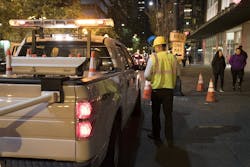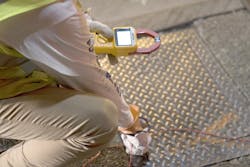Shocks and electrocutions linked to exposed and publicly accessible energized electrical infrastructure are rare events, but this hidden danger that can lurk undetected for long periods is keeping municipalities, utilities, and other jurisdictions focused on minimizing risk. Efforts are taking the form of stepped-up maintenance and repair, contact voltage testing programs, more routine inspections, and ensuring that new and rebuilt elements are designed and installed to applicable codes.
Heightened concern is also translating to resurgent debate in some quarters over the best techniques for making infrastructure inherently safer out of the gate, specifically methods for effectively grounding circuits. That’s a primary fail-safe barrier to potentially dangerous encounters with contact voltage, an emerging concern evidenced partly by the 2016 release of IEEE 1695, a “Guide to Understanding, Diagnosing and Mitigating Stray and Contact Voltage.”
That may warrant attention for multiple reasons. An aging electrical infrastructure, the prospect of ever more public-facing energized equipment, and fears of reduced maintenance resources could portend a future of more encounters — and more shocks, injuries, and deaths. Fairly recent history may provide ample justification for increased attention.
In fall 2014, a Michigan boy was electrocuted when he came into contact with an energized fence on the grounds of a high school. An investigation determined that a missing ground wire between two light posts on a nearby field and a short-circuited conductor caused electricity to travel to the fence.
In 2013, a 12-year-old girl was electrocuted when she slipped on a rainy day and fell onto an in-ground junction box in downtown Salina, Kan. The box contained damaged, short-circuited conductors, which had been installed without a grounding wire.
Treasured human companions, too, are having unfortunate encounters. In October 2018, four horses with police mounts were shocked and fell to the ground when they contacted a live buried wire on the grounds of a school. There have also been numerous incidents of dogs coming into contact with energized equipment; they’re especially susceptible partly because they’re more free-ranging, and four legs and padded feet yield more exposure. Among recent incidents, a dog was electrocuted in Boston in early 2018 after encountering a streetlight control box that had apparently become energized due to corroded wiring insulation.
A comprehensive database of contact voltage events is hard to come by, but the president of UTGIS, a Port St. Lucie, Fla., provider of stray and contact voltage testing services, says any compilation probably understates the problem.
“There’s some documentation that over a period of recent time there were over 200 cases of human or animal contact; in one Colorado city there were 70 of 50V or higher,” says Mark Voigtsberger. “But a lot go unreported because the shock isn’t felt.”
Looking for Problems
With incidents on the rise, or perhaps increasingly more documented — Voigtsberger suspects social media may be fueling reporting and awareness — efforts to locate and repair sources of contact voltage may be getting higher priority.
Business has been brisk for UTGIS, Voigtsberger says, as electrical infrastructure owners look for ways to complement and accelerate their own push to shore up system safety. UTGIS and like companies deploy highly sensitive voltage detection equipment on vehicles that can cover ground quickly, identify areas in need of attention and speed up repair response. Mobile testing, he says, gives system owners a quick way to get a bead on addressing potential problems.
“Some of this infrastructure can be 50 to 70 years old and has wiring that’s degrading and in need of maintenance,” Voigtsberger says. “A mobile system identifies problems that can be repaired on the spot. If we find something above a threshold, of say 25V, repair crews can be dispatched immediately.”
Seattle City Light, the municipal electric utility serving Seattle and areas around it, heavily ramped up contact voltage testing in 2010 after a dog’s electrocution stirred public and, in turn, utility concern. A company was initially hired to perform manual testing, but that proved too cumbersome and costly, says Steve Crume, streetlight engineering manager. Eager to speed up the process and improve accuracy and efficiency, the electric utility subsequently contracted with Power Survey Co., Kearny, N.J., to conduct mobile testing, which has been done annually, system wide, ever since.
“They can cover an entire service area in about 10 weeks, and the technology can detect less than a single volt from 30 ft away with uncanny accuracy,” Crume says.
Findings of 30V or more have prompted an immediate response, Crume says, while five or less have triggered no investigation, though it may be warranted because danger can be present in that range. So, beginning in 2019, Crume says, the electric utility will also begin testing a triage or “matrix-style” approach to better prioritizing response based on multiple factors like voltage levels, third harmonic frequency data, type of structure, and domain (private or public).
The city of Kansas City, Mo., doesn’t conduct contact voltage testing, opting instead for an aggressive, multi-layered inspection and maintenance program. It was considered, says Mahmoud Hadjian, assistant city engineer and division manager for streetlighting services, but ultimately was not implemented.
“With our night patrol program, regular cleanings, inspections and call-ins, every streetlight is getting looked at in some way at least monthly, as well as every four years,” says Hadjian. “So, we don’t have a system that’s falling apart, with broken neutrals or loose connections, that no one’s touched for years.”
That, along with the fact most streetlight circuits are less than 20 years old and are in conduit rather than direct buried, has produced a clean record with respect to documented cases of stray voltage hurting people or animals, Hadjian says.
In the course of its testing, for instance, Seattle has recorded a fluctuating number of contact voltage “events.” After 62 events of 30V or more were uncovered in 2010, the number plunged to the single digits for a few years and then plateaued in the annual 13-16 range, Crume says. Through early December 2018, 17 such events were recorded by mobile testing, 10 of which implicated utility-owned infrastructure.
Further insight into the extent of the problem comes from three of four states that require municipalities and utilities to log and report contact voltage when it’s revealed during routine inspections. Compiling data from Massachusetts, New York, and Maryland, Voigtsberger discovered that in 2017, 3,068 findings were logged. Of that total, 62% were within utility-responsible systems, while the balance was customer-responsible. That’s slightly lower than the average of the last five years of 3,193.
Grounding Solutions
The persistence of the contact voltage problem, and its possible future acceleration in light of aging infrastructure needing repair, rehabilitation or replacement, continues to spur discussion of best practices for installation and maintenance. High on that target list are techniques for effective bonding and grounding, a topic with a rich history of debate with roots in the interpretation and applicability of codes, standards, and conventions.
Bonding and grounding is a top concern with respect to a leading source of contact voltage incidents: streetlight poles and related structures that dot transit grids and, if energized, pose a ready threat to unsuspecting pedestrians. Parsing his stray voltage data submitted by three states, Voigtsberger discovered that of the 3,068 contact voltage findings in 2017, streetlights/streetlight wiring were the source fault for 1,189 of them, or 39%. That’s slightly lower than the five-year average of 43%, but streetlights remained the dominant source.
“Street lighting is clearly the single largest contributor to the contact voltage problem,” he says.
Properly and reliably grounded, though, streetlight infrastructure could recede as a source of contact voltage danger as new systems are installed, and thus contribute to an overall reduction in the volume of shocks and electrocutions. But the best route to bonding and grounding that works and provides the greatest margin of safety is still up for debate and can elude systems designers who sometimes follow entrenched practices and seek to comply with codes that might not readily align.
That was illustrated in a 2017 presentation before a gathering of the Kansas City chapter of the Institute of Transportation Engineers (ITE). Reviewing different approaches to bonding and grounding streetlighting and traffic control circuits, John Harrell, P.E., operations manager – electrical engineering, for Wilson & Company, Kansas City, Mo., engineering firm, revisited the long-simmering debate over the use of ground rods, multi-grounded neutral systems, and equipment grounding conductors (EGC) to minimize the risk of encounters with contact voltage on light poles and related equipment.
Harrell, who’s long been interested in drawing attention to best practices for reducing contact voltage incidents, told the group that ground rods, by themselves, frequently deployed in utility-owned lighting systems that must comply with the performance-based National Electrical Safety Code (NESC) may not provide the most reliable grounding. A superior approach that provides more safety, one required by the more prescriptive National Electrical Code (NEC), which governs non-utility owners/operators of streetlights, is adding an EGC, he asserts.
“Grounding that follows the NEC by providing a safety ground in the form of a dedicated EGC, reduces the risk of electrocution,” he says. “Grounding using the neutral, under the NESC, is more risky.”
In an NESC-compliant system that requires effective grounding and defines it as one connected to the earth through low-impedance connections, Harrell explained, a ground rod might not be sufficient in the event of a ground fault. In designs where the circuit runs from pole to pole and the neutral is not bonded to the pole, ground resistance may be high enough to reduce ground fault current to a level that won’t trip a breaker or primary fuse. In that event, voltage in the pole can rise to levels that can severely endanger those who contact it.
“Depending on soil resistivity and grounding methods, you may not have effective grounding to meet the NESC,” he says.
Adding an EGC, Harrell’s presentation continued, provides more assurance that the pole won’t be energized in a fault condition. With a low-resistance safety ground installed, the fault current has a direct path back to the source, virtually ensuring the primary or secondary breaker/fuse will trip, leaving the pole safe.
Another configuration in which the circuit’s neutral is bonded at the pole — a multi-grounded neutral system — also provides a way for fault current to be carried away from the pole, Harrell noted. But if the neutral is broken or disconnected, that won’t occur — and the pole is at risk of becoming energized. Regardless of the scenario, Harrell says, a dedicated ground in NEC-compliant lighting means fault currents have a reliable low-resistance path back to the source, and non-functioning neutrals don’t become a factor.
Assessing Utility Systems
Nevertheless, a certain percentage of the nation’s streetlights are likely owned and operated by utilities that are exempt from the NEC. Even many that fall under non-utility control might not comply, due to their age or because they were acquired from utilities.
That doesn’t necessarily mean streetlights lacking a ground conductor present a statistically significant higher risk, only that most might not be as safe as they could be. And there’s some evidence to that effect. The state data, Voigtsberger says, points to utility-responsible assets being more problematic.
“Most stray/contact voltage problems originate from the application of the NESC, but that number represents multiple different objects,” he asserts. “Customer equipment, such as traffic signals or other devices following UL and the NEC, represent the smallest source of stray/contact voltages found during testing surveys.”
Seattle City Light is grounding new and rebuilt streetlight systems in a way that conforms to the NESC, Crume says. Its standard, adopted five years ago, calls for ground systems that meet a resistance-to-earth test of 25 ohms or less.
“The current construction practice is to install this counterpoise grounding system in every trench, with the bare copper wire mechanically bonded to each grounding electrode in the circuit, maintaining direct-earth contact under the duct bank,” Crume says. “This is not a grounding conductor, but instead what amounts to a really long grounding electrode. Soil conditions vary dramatically in our service territory. Using a four-wire conductor with a dedicated neutral and a dedicated ground, it’s compliant with NESC. The EGC from each pole and light is connected to this system. These NESC alternate grounding systems do mirror NEC requirements in some ways.”
Crume says this grounding solution emerged from intense study of various techniques and considered the high resistivity of the city’s soils. As an example of the effectiveness of a counterpoise grounding system, “we were able to reduce ground resistance from more than 400 ohms to less than five ohms,” he says. “The purpose is to make a low-impedance path to ground to ensure overcurrent protection devices work as designed. We do power-on tests to confirm that the overcurrent protection operates as intended any time we commission a new or replacement lighting system.”
In Kansas City, new streetlight installations of any size are configured with a grounding conductor per the NEC, Hadjian says. Thousands of others, though, many purchased from the local utility years ago, were designed to the NESC, utilize ground rods or base designs that can provide some degree of grounding, and were grandfathered in. The city, though, did upgrade many to conform to a multi-grounded neutral design that utilizes a neutral bonded to the pole.
“There wasn’t enough money to put a disconnect on everything,” Hadjian says. “But I can’t say that what we have is unsafe. A grounding conductor does add one more level of safety. But since the neutral will carry any type of fault, these are effectively grounded unless something crazy happens, and there’s a break in the neutral.”
That may fall short of the NEC ideal of an EGC, but Hadjian, who attended the KC ITE event and appreciates the strict view on grounding, sees room for differing views of risk assessment. Harrell, though, who views the contact voltage problem in a context of numerous documented injuries/deaths and prospects for more as systems age, sees a need to redouble efforts to increase the margin of safety under the NEC’s guidance.
“When installing new streetlighting systems, or when existing streetlighting systems are substantially modified, provide the grounding prescribed by the National Electrical Code,” he says. “This means no longer using multi-grounded shared neutral wiring, and instead using both an insulated neutral conductor along with a grounding conductor.”
Zind is a freelance writer based in Lees Summit, Mo. He can be reached at [email protected].






